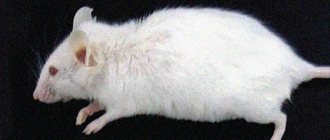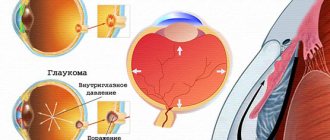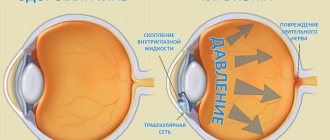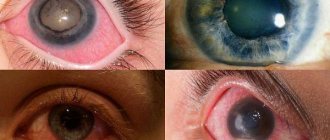Strictly speaking, glaucoma is not one disease, but a whole group of diseases with similar symptoms. They are characterized by:
- increased intraocular pressure - it can be either constant or episodic;
- damage and subsequent atrophy of the optic nerve;
- decreased visual acuity, impaired visual function.
Sign up for a free vision test
According to statistics, more than 70 million people suffered from this disease in 2021. In Russia, the number of cases is estimated at approximately one million. Glaucoma is the second most common cause of blindness, second only to cataracts. It is very important to be regularly examined by a specialist!
The purpose of this article is to give a general idea of glaucoma, talk about the causes of this disease, symptoms, treatment and prevention.
Types of glaucoma
The space of the eye, filled with a transparent liquid and limited on one side by the cornea and on the other by the iris, is called the anterior chamber. There is an area called the anterior chamber angle, or ACA. In the outer wall of the UPC there is a drainage system of the eye, providing controlled outflow of intraocular fluid. Fluid circulation maintains intraocular pressure (IOP) at a constant level, and disruption of its function leads to an increase in pressure.
Accordingly, there are two main types of glaucoma:
- closed angle;
- open angle.
The first type, that is, angle-closure glaucoma, is less common; according to various estimates, it affects from 10 to 20% of the total number of cases. Most often, people over the age of 30 who also have farsightedness encounter it.
The specificity of this type is that the iris overlaps the anterior chamber angle (ACA) of the eye. For this reason, the natural drainage system is disrupted, and pressure increases in the visual organ. This may be accompanied by:
- severe headache;
- redness of the eye;
- blurred vision and other visual impairments, including complete blindness.
Open-angle glaucoma is detected in approximately 80-90% of those who experience increased IOP. In this case, access to the natural drainage system remains open, but it does not work properly. As a result, the pressure inside the eye gradually increases. Such a disease can be asymptomatic, which is especially dangerous, since a person can suddenly, without any clear reason, feel that the quality of his vision has noticeably decreased.
All the nuances of preventing cataracts and glaucoma
What a funny material. Somehow they insistently repeat “cloudiness”, “cloudness”, “cloudness” and carefully avoid the question of what kind of cloudiness this is that has clouded the lens, that is, how this is expressed histologically. And the answer is primitively simple: these are calcium deposits, often not only in the lens, but also on the sclera, on the periphery of the eye, which is often observed in older people. Treatment of cataracts takes a long time, but in principle is very simple: you need to dissolve calcium in the lens, that is, restore the homeostasis of the metabolism of the calcium-magnesium metabolic pair, which must be balanced and be in the ratio Ca:Mg = 2: 1, for two molecules of calcium one molecule of magnesium . In Russia, this ratio reaches 8:1, that is, the amount of calcium in the body many times exceeds the body’s ability to remove it. The pathogenetic conformation HYPERCALCIEMIA-HYPOMAGNEMIA-DEPRESSION OF BIOSYNTHESIS is almost total, which gives rise to a group of metabolic diseases that need to be combined into a nosological group, these are all dysplastic, involutional-degenerative diseases, such as cardiomyopathy, atherosclerosis, coronary heart disease, bronchopulmonary dysplasia, vertebropathies , including osteochondrosis, including cataracts. Disturbances of the homeostasis of mineral metabolism - diselementosis, or disturbances of metal-ligand homeostasis - are basic conditions, biological constants of life, as important as physical constants - gravitational force, speed of light, physical characteristics of water, electromagnetic field, temperature parameters, atmospheric composition. It is the ignorance of biological constants, biological nihilism that is the reason for the insignificance and failure of modern “medicine”, the consequences of which lead to biological degradation and physical death of the homo sapiens species. You are told that there is such a “medicine” and it can supposedly protect you from illness and death; all you have to do is come, find your “disease” and buy a “medicine” or a procedure; even the term “medicalization of consciousness” has appeared, that is, a suggestive technology intended for your enslavement, increasing dependence on interference in your body, and each such step should strengthen the dependence. For example, in the maternity hospital they applied a protocol for active labor management to you, without allowing the cascade of biochemical processes that prepare the child’s body to breathe atmospheric air to complete. The result was brain hypoxia and organic brain disorders - encephalopathy. Everything - now you can endlessly treat nervous and psychotic disorders, you are already a slave to “medicine” for life. They shied away from the wild vaccine at a very tender age, immediately after giving birth. A mixture of toxins will work - it will manifest itself in a poisoned liver, decreased immunity, and allergic reactions. Medicine practically first carefully prepares the material - the substrate for parasitism, and then makes faces, pretending to “save” you and demands recognition and money. I’m not exaggerating - this is exactly what the former “health care” looks like now, which has turned into a greedy, vile, brazenly arrogant, despising the sick like a bandit despises the victim, the “health industry”. It’s a pity for the doctors who could not transform, they are still the majority. Confused, trampled socially and economically, weak-willed and helpless, unable to either agree on some kind of constructive opposition to what is happening, or even recognize themselves in this substance, not daring to admit their collapse as social creatures, very sick... They have created a trap - the “medical community” ", a social fiction, they were inspired to defend the interests of this monster, supposedly from the profane, from the sick, from any criticism, they implanted aggressiveness towards strangers, and they die in this existential loop, not at all in the name of professional solidarity, but in the name of infernal evil, destroying them themselves.
Causes of glaucoma
The balance of inflow and outflow of intraocular fluid maintains the pressure inside the healthy eye at approximately between 10 and 20 mmHg. Art. If normal fluid circulation is disrupted, pressure begins to rise. Problems arise with blood circulation in the structures of the eye, the fibers of the optic nerve die, the field of vision gradually narrows, and then the optic nerve may atrophy, and then complete blindness occurs.
Currently, experts cannot say unambiguously for what reasons glaucoma occurs. The appearance of this disease is influenced by factors such as:
- heredity;
- individual anatomical features, specific structure of the visual organs in a particular person;
- various pathologies of the cardiovascular, nervous and endocrine systems.
Risk factors for the development of glaucoma include a small volume of the anterior chamber of the eye. This structural feature of the organ of vision is found in some nationalities - Eskimos and residents of East Asia. This anatomical feature is more common in women than in men, so their risk of developing glaucoma is slightly higher.
The presence of age-related and genetic risk factors is the reason why many people should be examined at least once a year for suspected glaucoma. This primarily concerns those who:
- over 40 years of age – the likelihood of developing the disease increases with age;
- suffers from other eye diseases, such as cataracts, tumors, acute inflammation;
- has diseases of the cardiovascular, endocrine and nervous systems;
- has been taking or has taken hormonal medications for a long time;
- has relatives who have been diagnosed with glaucoma.
Principles of treatment in the presence of two ailments at once
Conservative treatment of diseases of the visual organs is based on the use of the following groups of drugs:
- selective sympathomimetics;
- miotics;
- carbonic anhydrase inhibitors;
- prostalandins F2 alpha;
- beta blockers;
- combined means.
If the development of cataracts and glaucoma is noticed at an early stage, intraocular pressure is reduced with the help of drops such as Xalatan. Fotil, Betoptik. Drops containing vitamins can also slow down the development of cataracts: Quinax, Taufon, Oftan Katahrom. Additionally, you can take vitamin complexes with lutein.
To speed up eye metabolism, vacuum massage, phonophoresis, color pulse therapy, and infrasound are prescribed. Exercises with Pankov and Sidorenko glasses bring relief.
In the later stages of the development of cataracts and glaucoma, vision loss can only be prevented by surgery. Several years ago, specialists refused to replace the lens when intraocular pressure was more than 25 mmHg. Art. and eye damage from glaucoma and cataracts at the same time. First, an operation was performed aimed at reducing IOP, and only after normalization of pressure was the degraded lens replaced with an artificial one.
Modern methods of therapy are based on one-stage treatment of cataracts and glaucoma. There are several types of surgical intervention:
- Trabeculectomy. Lowers intraocular pressure and ensures the outflow of fluid accumulating in the eye organs.
- Canaloplasty. An incision is made in the tissues of the organ of vision to access Schlemm's canal. Passing the catheter around the iris will temporarily widen the channel and lower the IOP.
- Laser correction. Using a laser, the windows of the trabecular meshwork are enlarged and the outflow of stagnant fluid is normalized. This technique is considered the most effective and least traumatic.
- Installation of implants. If gentle treatment methods do not bring the expected result, a valve or shunt tube is placed inside the organ of vision.
Stages of glaucoma
The disease goes through several stages in its development. The transition to a more serious stage is usually expressed in the appearance of visual field defects. The field of view is the space that a person sees around him when looking at a certain point.
At the initial stage of the disease, loss of small central areas of the visual field most often occurs. The patient may either not notice this at all, or pay attention to small dark spots in front of the eyes.
Then peripheral vision gradually deteriorates. A person with glaucoma sees more or less well only what is directly in front of him. But over time, the central field of vision narrows—experts often use the term “tunnel vision” because a person feels as if they are looking at the world through a long, narrow tube. A veil appears before the eyes; it may seem that dark dots are running in front of them.
At the last stage of glaucoma, which is called terminal, complete loss of vision occurs.
Symptoms of glaucoma
Obviously, the sooner ophthalmologists make an appropriate diagnosis, the greater the likelihood that the problem will be affected. However, signs of glaucoma, as mentioned above, often do not appear. Therefore, a person can find out about the presence of serious complications, for example, by visiting a specialist for a completely different reason.
Glaucoma is often discovered accidentally during a routine visit to the ophthalmologist.
However, there are a number of symptoms that clearly indicate that you need to see a doctor
. This:
- blurred vision;
- the occurrence of a sharp headache, including only in one half of the head;
- pain in the eye area;
- the appearance of rainbow halos around light sources;
- redness of the eye;
- blurred vision in low light, especially in the evening and at night;
- loss of peripheral vision.
Find your nearest optical store
Prevention
Preventing glaucoma is especially important for people over 45 years of age. They should follow simple recommendations from doctors - this will reduce the likelihood of the development and progression of the disease:
- Do not lift weights exceeding 12 kg;
- you need to ensure that your night's sleep is regular, sound and lasts at least 8 hours;
- people with a hereditary predisposition to glaucoma should not be in a position in which the head is tilted forward for a long time - washing floors, weeding the garden or picking berries;
- it is necessary to control blood pressure, monitor the amount of fluid and salt consumed, drink less coffee and eat more plant foods;
- You should avoid overwork, stress and nervous tension;
- It is undesirable to be in rooms with sudden changes in lighting;
- it is necessary to protect your eyes from sudden flashes;
- it is better to refuse to visit cinemas or reduce such visits to a minimum;
- stop drinking alcohol and tobacco.
Glaucoma treatment
Damage to the optic nerve and, especially, vision loss due to glaucoma are irreversible. However, there are ways to normalize intraocular pressure and thereby prevent or stop the progression of the disease.
Conservative, that is, drug treatment involves the use of various medications, primarily eye drops. At the same time, it is necessary to understand that they do not “cure” in the literal sense of the word, that is, they do not change the structure of the eye in such a way that the natural fluid outflow system works again without disruption. They artificially maintain fluid balance in the eye. If you stop using the drops, after a while the disease will begin to progress.
Surgical treatment of glaucoma is used in cases where medications do not help. The main goal of the operation is to remove obstacles to the outflow of intraocular fluid or to create new pathways. There are several ways to achieve this. Most often, specialists:
- use modern laser techniques to, for example, expand existing or create new channels for outflow of IOP;
- special devices are implanted through which intraocular fluid is removed: tubes, drains, valves.
Therapy methods
If you experience discomfort or the first symptoms of glaucoma, you should consult an ophthalmologist. The doctor will examine the patient, diagnose the disease and prescribe special treatment. Treatment options include drug therapy, surgical treatment methods, and folk remedies. Also, each patient is given a special diet.
Drug treatment
The following drugs are used:
- Drugs that improve the outflow of intraocular fluid: miotics - Pilocarpine hydrochloride, Aceclidine;
- sympathomimetics - “Norepinephrine”;
- prostaglandins - “Bioprostin”, “Bioran”.
- beta-blockers - “Oftan timolol”, “Betoptik”;
During an acute attack:
- Pilocarpine 1% and Timolol are instilled.
- Anesthetics are administered - “Promedol”, “Analgin”.
- They give a diuretic - Furosemide (to control blood pressure).
- Diakarb and Asparkam are used.
- When the attack is relieved, surgical treatment methods are recommended.
Surgical treatment
Thanks to modern treatment methods, most patients manage to maintain their vision and joy in perceiving the world around them.
To restore vision, the following types of operations are used:
- Laser iridectomy involves creating a through hole on the periphery of the iris. Before surgery, miotics are instilled into the eyes. Next, a hypolens is placed on the eye, which focuses the laser beam onto the area of the iris. After the operation is completed, anti-inflammatory drops are prescribed.
- Trabeculoplasty is based on the action of a laser beam on the trabecular area. After surgery, the pressure in the eyes improves. The procedure prevents complications.
- Sinustrabeculectomy - its essence lies in the formation of a new path for the outflow of moisture under the conjunctiva, from where it is absorbed by the surrounding tissues.
Traditional methods of treatment
The following healer recipes are used:
- Take a kilogram of duckweed and chop thoroughly. Then add 200 milliliters of alcohol and let it steep for a week. Take 2 teaspoons before meals with water, 3 times a day.
- Take 10 grams of cumin, coriander, anise berries, dill and pour everything into two glasses of hot water. After cooling, you need to strain. Drink 100 ml 3 times a day.











